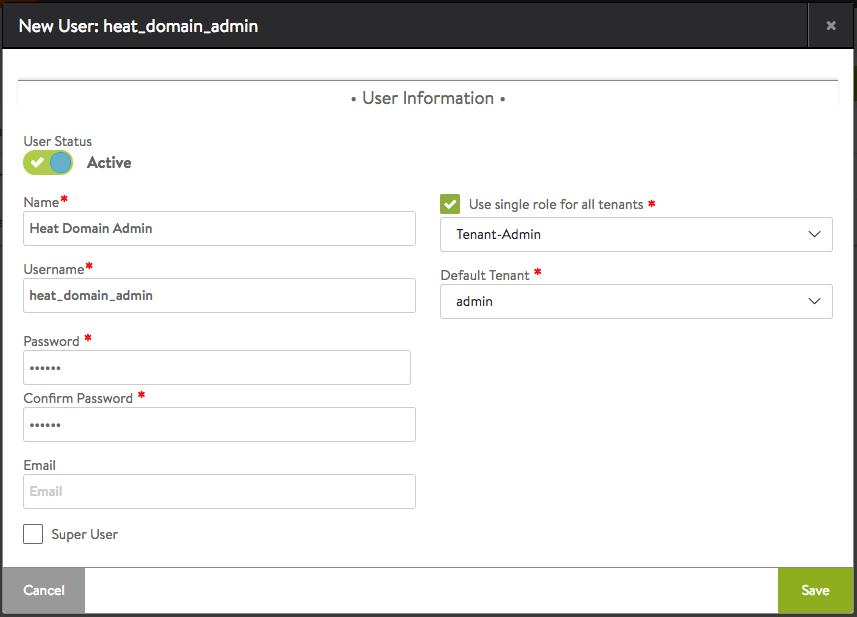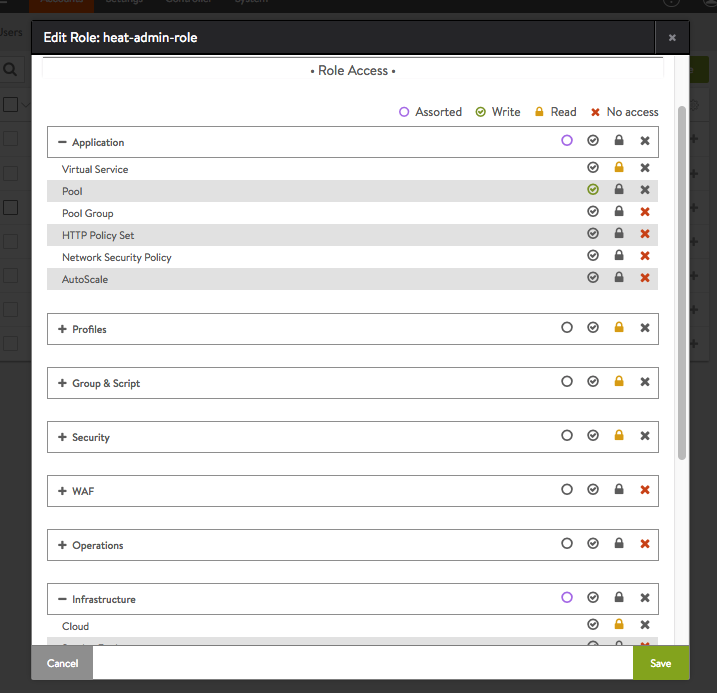-
Install the AviHeat PIP Package from https://github.com/avinetworks/avi-heat/releases
-
Update your /etc/heat/heat.conf and add the following in the [Default] section:
-
Ubuntu
plugin_dirs = '/usr/local/lib/python2.7/dist-packages/avi/heat'
-
Red Hat (RHEL / CentOS)
plugin_dirs = '/usr/lib/python2.7/site-packages/avi/heat'
-
-
Provide the IP address or FQDN for the Avi Controller. Use one of the following options:
-
OPTION 1: In heat.conf Update your /etc/heat/heat.conf and add the following in the [Default] section:
avi_controller = '10.10.25.200'
-
OPTION 2: Via avi-lbaas service in keystone catalog Please refer to Avi Knowledge Brief at https://avinetworks.com/docs/18.2/installing-the-lbaas-driver-cli-shell-openstack/#adding-a-keystone-catalog-entry-for-avi-vantage for details on how to define avi-lbaas service and an endpoint for it in your keystone catalog.
-
-
Restart heat-engine after adding this. For example:
$> service heat-engine restart
-
For implementing AutoScalingGroup, Heat engines use the credentials configured under stack_domain_admin variable /etc/heat.conf. So, an AutoScalingGroup with template containing Avi resouces will work only if the Heat Engine can login to Avi Controller using those same stack_domain_admin credentials.
For example, consider the following settings in /etc/heat.conf:
... stack_domain_admin = heat_domain_admin stack_domain_admin_password = abc123 ...
In this case, you need to create a user named "heat_domain_admin" on Avi Controller using the same password as defined in the heat.conf. We recommend granting this user Tenant-Admin role in all tenants so that any Avi resource can be created, updated, or deleted via the templates used in AutoScalingGroup. However, if this is deemed a security issue, you can create a new role in Avi with specific privileges and assign only that role to this new user.
The following picture shows how to create such user in Avi UI.
Alternatively, you can perform a POST API for /api/user URI with the following data (role_ref needs to be replaced with the url corresponding to the Tenant-Admin role):
{
"username": "heat_domain_admin",
"password": "abc123",
"full_name": "Heat Domain Admin",
"is_active": True,
"access": [{"all_tenants": True,
"role_ref": role_ref}],
"default_tenant_uuid": "admin",
"require_password_confirmation": False,
}
The following picture shows a more restricted custom role on Avi that only allows write access to the Pool resource. By assigning such a role to the stack_domain_admin user instead of Tenant-Admin role, one can allow an AutoScalingGroup to automatically add members to a group, but not allow write access to any other objects in the system.
Create a yaml file to add to your deployment script options:
$> cat heat-avi.yaml
parameter_defaults:
HeatEnginePluginDirs: ['/usr/share/avi/heat']
HeatEngineOptVolumes:
- /usr/share/avi:/usr/lib/python2.7/site-packages/avi:ro
ControllerExtraConfig:
heat::config::heat_config:
DEFAULT/avi_controller:
value: <FQDN>
Add it to your deployment script. If you are not using Option 2 in step 3 above (to provide Avi Controller IP Address) you can remove the ControllerExtraConfig
Once installed, Heat will expose Avi resource types that users can specify in their heat templates. For a full list of resource types, use the following command (or use "openstack orchestration resource type list" when heat CLI client is not available):
$> heat resource-type-list | grep Avi ... | Avi::LBaaS::Pool | | Avi::LBaaS::Pool::Server | | Avi::LBaaS::Role | | Avi::LBaaS::SSLProfile | | Avi::LBaaS::SeProperties | ...
For a full list of attributes available for any resource type, use the following command (or use "openstack orchestration resource type show Avi::LBaaS::Pool" when heat CLI client is not available):
$> heat resource-type-show Avi::LBaaS::Pool
...
"properties": {
"lb_algorithm": {
"description": "The load balancing algorithm will pick a server within the pool's list of available servers.",
"required": false,
"update_allowed": true,
"type": "string",
"immutable": false,
"constraints": [
{
"allowed_values": [
"LB_ALGORITHM_ROUND_ROBIN",
"LB_ALGORITHM_LEAST_LOAD",
...
For properties that need UUIDs, you can specify a name but prefixed with string "get_avi_uuid_by_name:":
...
member:
type: Avi::LBaaS::Pool::Server
properties:
pool_uuid: get_avi_uuid_by_name:testpool
...
Internally, heat-engine would perform an API call to resolve the provided name into Avi UUID. For a complete example, please refer to test-member.yaml in examples directory: https://github.com/avinetworks/avi-heat/blob/master/examples/test-member.yaml.
If you want to provide the name for a UUID property via an input parameter to your template, please refer to the example in test-member-pool-as-param.yaml: https://github.com/avinetworks/avi-heat/blob/master/examples/test-member-pool-as-param.yaml:
...
parameters:
pool_name:
type: string
...
resources:
member:
type: Avi::LBaaS::Pool::Server
properties:
pool_uuid:
str_replace:
template: get_avi_uuid_by_name:pname
params:
pname: { get_param: pool_name }
...
Starting version 17.1.X, Avi Vantage supports API versioning and backwards compatability. Avi Heat plugin leverages this backwards compatability. Thus, any heat template written for a version of Avi Vantage continues to work even when the Avi Vantage software or the Avi Heat plugin is updated to a later version.
For each Avi Resource, any attribute that is newly introduced in a specific version is noted with phrase "(Introduced in: <version>)" in the description of that attribute. Similarly, phrase "(Deprecated in: <version>)" denotes the version a specific attribute is deprecated in. An attribute that doesn’t have either of those notations is available is valid across all versions.
Each Avi Resource has a special attribute called "avi_version", that can be used by the users to explicitly specify a version to use when creating that resource. When no version is specified, the resource definition can only use those attributes that don’t have "Introduced in" annotation in their descriptions. To be able to use attributes with "Introduced in" annotation, one has to set the "avi_version" attribute to a version equal to or higher than the version mentioned in the "Introduced in" annotation. For example, if an attribute has "(Introduced in: 17.1.3)" annotation in the description, then the "avi_version" attribute has to be set to either "17.1.3" or higher (e.g., "17.1.6" or "18.1.2").
Note that once the "avi_version" attribute of a resource is set, all attributes of that resource that are deprecated in a version equal to or lower than that version can not be used in that resource’s definition in that template.
Consider the following example snippet for using Avi::LBaaS::VirtualService resource type:
...
vs:
type: Avi::LBaaS::VirtualService
properties:
name: "mytestvs"
pool_uuid: {get_resource: pool}
ip_address:
addr: 10.10.10.100
type: V4
services:
- port: 80
...
The above does not use any attributes with "(Introduced in: <version>)" annotation in their descriptions. Hence, the resource doesn’t need to have the "avi_version" attribute set. Suppose you want to use the concept of shared VIPs introduced in Avi Vantage version 17.1.1. The following template shows the exact same VirtualSerice definition as above but using the attribute "vip" that is only available from versions 17.1.1 and beyond:
...
vs:
type: Avi::LBaaS::VirtualService
properties:
avi_version: 17.1.1
name: "mytestvs"
pool_uuid: {get_resource: pool}
vip:
- ip_address:
addr: 10.10.10.100
type: V4
vip_id: myvip
services:
- port: 80
...

